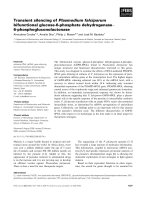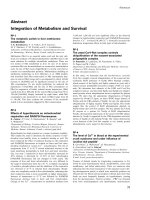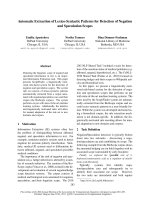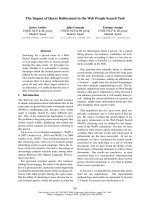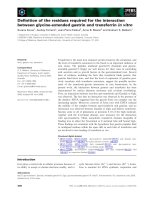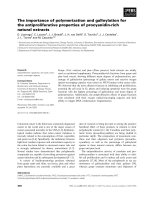Báo cáo khoa học: "Probabilistic Integration of Partial Lexical Information for Noise Robust Haptic Voice Recognition" doc
Bạn đang xem bản rút gọn của tài liệu. Xem và tải ngay bản đầy đủ của tài liệu tại đây (745.5 KB, 9 trang )
Proceedings of the 50th Annual Meeting of the Association for Computational Linguistics, pages 31–39,
Jeju, Republic of Korea, 8-14 July 2012.
c
2012 Association for Computational Linguistics
Probabilistic Integration of Partial Lexical Information for Noise Robust
Haptic Voice Recognition
Khe Chai Sim
Department of Computer Science
National University of Singapore
13 Computing Drive, Singapore 117417
Abstract
This paper presents a probabilistic framework
that combines multiple knowledge sources for
Haptic Voice Recognition (HVR), a multi-
modal input method designed to provide ef-
ficient text entry on modern mobile devices.
HVR extends the conventional voice input by
allowing users to provide complementary par-
tial lexical information via touch input to im-
prove the efficiency and accuracy of voice
recognition. This paper investigates the use of
the initial letter of the words in the utterance
as the partial lexical information. In addition
to the acoustic and language models used in
automatic speech recognition systems, HVR
uses the haptic and partial lexical models as
additional knowledge sources to reduce the
recognition search space and suppress confu-
sions. Experimental results show that both the
word error rate and runtime factor can be re-
duced by a factor of two using HVR.
1 Introduction
Nowadays, modern portable devices, such as the
smartphones and tablets, are equipped with micro-
phone and touchscreen display. With these devices
becoming increasingly popular, there is an urgent
need for an efficient and reliable text entry method
on these small devices. Currently, text entry us-
ing an onscreen virtual keyboard is the most widely
adopted input method on these modern mobile de-
vices. Unfortunately, typing with a small virtual
keyboard can sometimes be cumbersome and frus-
tratingly slow for many people. Instead of using
a virtual keyboard, it is also possible to use hand-
writing gestures to input text. Handwriting input
offers a more convenient input method for writing
systems with complex orthography, including many
Asian languages such as Chinese, Japanese and Ko-
rean. However, handwriting input is not necessarily
more efficient compared to keyboard input for En-
glish. Moreover, handwriting recognition is suscep-
tible to recognition errors, too.
Voice input offers a hands-free solution for text
entry. This is an attractive alternative for text entry
because it completely eliminates the need for typ-
ing. Voice input is also more natural and faster for
human to convey messages. Normally, the average
human speaking rate is approximately 100 words
per minute (WPM). Clarkson et al. (2005) showed
that the typing speed for regular users reaches only
86.79 – 98.31 using a full-size keyboard and 58.61
– 61.44 WPM using a mini-QWERTY keyboard.
Evidently, speech input is the preferred text entry
method, provided that speech signals can be reli-
ably and efficiently converted into texts. Unfortu-
nately, voice input relies on automatic speech recog-
nition (ASR) (Rabiner, 1989) technology, which re-
quires high computational resources and is suscep-
tible to performance degradation due to acoustic in-
terference, such as the presence of noise.
In order to improve the reliability and efficiency
of ASR, Haptic Voice Recognition (HVR) was pro-
posed by Sim (2010) as a novel multimodal input
method combining both speech and touch inputs.
Touch inputs are used to generate haptic events,
which correspond to the initial letters of the words in
the spoken utterance. In addition to the regular beam
31
pruning used in traditional ASR (Ortmanns et al.,
1997), search paths which are inconsistent with the
haptic events are also pruned away to achieve further
reduction in the recognition search space. As a re-
sult, the runtime of HVR is generally more efficient
than ASR. Furthermore, haptic events are not sus-
ceptible to acoustic distortion, making HVR more
robust to noise.
This paper proposes a probabilistic framework
that encompasses multiple knowledge sources for
combining the speech and touch inputs. This frame-
work allows coherent probabilistic models of dif-
ferent knowledge sources to be tightly integrated.
In addition to the acoustic model and language
model used in ASR, haptic model and partial lexi-
cal model are also introduced to facilitate the inte-
gration of more sophisticated haptic events, such as
the keystrokes, into HVR.
The remaining of this paper is organised as fol-
lows. Section 2 gives an overview of existing tech-
niques in the literature that aim at improving noise
robustness for automatic speech recognition. Sec-
tion 3 gives a brief introduction to HVR. Section 4
proposes a probabilistic framework for HVR that
unifies multiple knowledge sources as an integrated
probabilistic generative model. Next, Section 5
describes how multiple knowledge sources can be
integrated using Weighted Finite State Transducer
(WFST) operations. Experimental results are pre-
sented in Section 6. Finally, conclusions are given
in Section 7.
2 Noise Robust ASR
As previously mentioned, the process of converting
speech into text using ASR is error-prone, where
significant performance degradation is often due to
the presence of noise or other acoustic interference.
Therefore, it is crucial to improve the robustness
of voice input in noisy environment. There are
many techniques reported in the literature which
aim at improving the robustness of ASR in noisy
environment. These techniques can be largely di-
vided into two groups: 1) using speech enhance-
ment techniques to increase the signal-to-noise ratio
of the noisy speech (Ortega-Garcia and Gonzalez-
Rodriguez, 1996); and 2) using model-based com-
pensation schemes to adapt the acoustic models to
noisy environment (Gales and Young, 1996; Acero
et al., 2000).
From the information-theoretic point of view, in
order to achieve reliable information transmission,
redundancies are introduced so that information lost
due to channel distortion or noise corruption can be
recovered. Similar concept can also be applied to
improve the robustness of voice input in noisy en-
vironment. Additional complementary information
can be provided using other input modalities to pro-
vide cues (redundancies) to boost the recognition
performance. The next section will introduce a mul-
timodal interface that combines speech and touch in-
puts to improve the efficiency and noise robustness
for text entry using a technique known as Haptic
Voice Recognition (Sim, 2010).
3 Haptic Voice Recognition (HVR)
For many voice-enabled applications, users often
find voice input to be a black box that captures the
users’ voice and automatically converts it into texts
using ASR. It does not provide much flexibility for
human intervention through other modalities in case
of errors. Certain applications may return multiple
hypotheses, from which users can choose the most
appropriate output. Any remaining errors are typi-
cally corrected manually. However, it may be more
useful to give users more control during the input
stage, instead of having a post-processing step for
error correction. This motivates the investigation of
multimodal interface that tightly integrates speech
input with other modalities.
Haptic Voice Recognition (HVR) is a multimodal
interface designed to offer users the opportunity to
add his or her ‘magic touch’ in order to improve
the accuracy, efficiency and robustness of voice in-
put. HVR is designed for modern mobile devices
equipped with an embedded microphone to capture
speech signals and a touchscreen display to receive
touch events. The HVR interface aims to combine
both speech and touch modalities to enhance speech
recognition. When using an HVR interface, users
will input text verbally, at the same time provide ad-
ditional cues in the form of Partial Lexical Infor-
mation (PLI) to guide the recognition search. PLIs
are simplified lexical representation of words that
should be easy to enter whilst speaking (e.g. the
32
prefix and/or suffix letters). Preliminary simulated
experiments conducted by Sim (2010) show that
potential performance improvements both in terms
of recognition speed and noise robustness can be
achieved using the initial letters as PLIs. For ex-
ample, to enter the text “Henry will be in Boston
next Friday”, the user will speak the sentence and
enter the following letter sequence: ‘H’, ‘W’, ‘B’,
‘I’, ‘B’, ‘N’ and ‘F’. These additional letter sequence
is simple enough to be entered whilst speaking; and
yet they provide crucial information that can sig-
nificantly improve the efficiency and robustness of
speech recognition. For instance, the number of let-
ters entered can be used to constrain the number of
words in the recognition output, thereby suppress-
ing spurious insertion and deletion errors, which are
commonly observed in noisy environment. Further-
more, the identity of the letters themselves can be
used to guide the search process so that partial word
sequences in the search graph that do not conform to
the PLIs provided by the users can be pruned away.
PLI provides additional complementary informa-
tion that can be used to eliminate confusions caused
by poor speech signal. In conventional ASR, acous-
tically similar word sequences are typically resolved
implicitly using a language model where contexts
of neighboring words are used for disambiguation.
On the other hand, PLI can also be very effective
in disambiguating homophones
1
and similar sound-
ing words and phrases that have distinct initial let-
ters. For example, ‘hour’ versus ‘our’, ‘vary’ versus
‘marry’ and ‘great wine’ versus ‘grey twine’.
This paper considers two methods of generating
the initial letter sequence using a touchscreen. The
first method requires the user to tap on the appropri-
ate keys on an onscreen virtual keyboard to generate
the desired letter sequence. This method is similar
to that proposed in Sim (2010). However, typing on
small devices like smartphones may require a great
deal of concentration and precision from the users.
Alternatively, the initial letters can be entered using
handwriting gestures. A gesture recognizer can be
used to determine the letters entered by the users. In
order to achieve high recognition accuracy, each let-
ter is represented by a single-stroke gesture, so that
isolated letter recognition can be performed. Fig-
1
Words with the same pronunciation
ure 1 shows the single-stroke gestures that are used
in this work.
4 A Probabilistic Formulation for HVR
Let O = {o
1
, o
2
, . . . , o
T
} denote a sequence of
T observed acoustic features such as MFCC (Davis
and Mermelstein, 1980) or PLP (Hermansky, 1990)
and H = {h
1
, h
2
, . . . , h
N
} denote a sequence of
N haptic features. For the case of keyboard input,
each h
i
is a discrete symbol representing one of the
26 letters. On the other hand, for handwriting input,
each h
i
represents a sequence of 2-dimensional vec-
tors that corresponds to the coordinates of the points
of the keystroke. Therefore, the haptic voice recog-
nition problem can be defined as finding the joint
optimal solution for both the word sequence,
ˆ
W and
the PLI sequence,
ˆ
L, given O and H. This can be
expressed using the following formulation:
(
ˆ
W,
ˆ
L) = arg max
W,L
P (W, L|O, H) (1)
where according to the Bayes’ theorem:
P (W, L|O, H) =
p(O, H|W, L)P (W, L)
p(O, H)
=
p(O|W)p(H|L)P (W, L)
p(O, H)
(2)
The joint prior probability of the observed inputs,
p(O, H), can be discarded during the maximisation
of Eq. 1 since it is independent of W and L. p(O|W)
is the acoustic likelihood of the word sequence, W,
generating the acoustic feature sequence, O. Simi-
larly, P (H|L) is the haptic likelihood of the lexical
sequence, L, generating the observed haptic inputs,
H. The joint prior probability, P (W, L), can be de-
composed into:
P (W, L) = P (L|W)P (W) (3)
where P (W) can be modelled by the word-based n-
gram language model (Chen and Goodman, 1996)
commonly used in automatic speech recognition.
Combining Eq. 2 and Eq. 3 yields:
P (W, L|O, H) ∝
p(O|W) × p(H|L) × P (L|W) × P (W)(4)
It is evident from the above equation that the prob-
abilistic formulation of HVR combines four knowl-
edge sources:
33
Figure 1: Examples of single-stroke handwriting gestures for the 26 English letters
• Acoustic model score: p(O|W)
• Haptic model score: p(H|L)
• PLI model score: P (L|W)
• Language model score: P (W)
Note that the acoustic model and language model
scores are already used in the conventional ASR.
The probabilistic formulation of HVR incorporated
two additional probabilities: haptic model score,
p(H|L) and PLI model score, P (L|W). The role
of the haptic model and PLI model will be described
in the following sub-sections.
4.1 Haptic Model
Similar to having an acoustic model as a statisti-
cal representation of the phoneme sequence generat-
ing the observed acoustic features, a haptic model is
used to model the PLI sequence generating the ob-
served haptic inputs, H. The haptic likelihood can
be factorised as
p(H|L) =
N
i=1
p(h
i
|l
i
) (5)
where L = {l
i
: 1 ≤ i ≤ N}. l
i
is the ith PLI
in L and h
i
is the ith haptic input feature. In this
work, each PLI represent the initial letter of a word.
Therefore, l
i
represents one of the 26 letters. As pre-
viously mentioned, for keyboard input, h
i
are dis-
crete features whose values are also one of the 26
letters. Therefore, p(h
i
|l
i
) forms a 26×26 matrix. A
simple model can be derived by making p(h
i
|l
i
) an
identity matrix. Therefore, p(h
i
|l
i
) = 1 if h
i
= l
i
;
otherwise, p(h
i
|l
i
) = 0. However, it is also possi-
ble to have a non-diagonal matrix for p(h
i
|l
i
) in or-
der to accommodate typing errors, so that non-zero
probabilities are assigned to cases where h
i
= l
i
.
For handwriting input, h
i
denote a sequence of 2-
dimensional feature vectors, which can be modelled
using Hidden Markov Models (HMMs) (Rabiner,
1989). Therefore, (h
i
|l
i
) is simply given by the
HMM likelihood. In this work, each of the 26 let-
ters is represented by a left-to-right HMM with 3
emitting states.
4.2 Partial Lexical Information (PLI) Model
Finally, a PLI model is used to impose the com-
patibility constraint between the PLI sequence, L,
and the word sequence, W. Let W = {w
i
: 1 ≤
i ≤ M} denote a word sequence of length M . If
M = N , the PLI model likelihood, P (L|W), can
be expressed in the following form:
P (L|W) =
N
i=1
P (l
i
|w
i
) (6)
where P (l
i
|w
i
) is the likelihood of the ith word, w
i
,
generating the ith PLI, l
i
. Since each word is rep-
resented by a unique PLI (the initial letter) in this
work, the PLI model score is given by
P (l
i
|w
i
) = C
sub
=
1 if l
i
= initial letter of w
i
0 otherwise
On the other hand, if N = M , insertions and dele-
tions have to be taken into consideration:
P (l
i
= |w
i
) = C
del
and P (l
i
|w
i
= ) = C
ins
where represents an empty token. C
del
and C
ins
denote the deletion and insertion penalties respec-
tively. This work assumes C
del
= C
ins
= 0.
This means that the word count of the HVR out-
put matches the length of the initial letter sequence
entered by the user. Assigning a non-zero value to
C
del
gives the users option to skip entering letters
for certain words (e.g. short words).
34
Figure 2: WSFT representation of PLI model,
¯
P
5 Integration of Knowledge Sources
As previously mentioned, the HVR recognition pro-
cess involves maximising the posterior probability
in Eq. 4, which can be expressed in terms of four
knowledge sources. It turns out that these knowl-
edge sources can be represented as Weighted Finite
State Transducers (WFSTs) (Mohri et al., 2002) and
the composition operation (◦) can be used to inte-
grate these knowledge sources into a single WFST:
¯
F
integrated
=
¯
A ◦
¯
L ◦
¯
P ◦
¯
H (7)
where
¯
A,
¯
L,
¯
P and
¯
H denote the WFST repre-
sentation of the acoustic model, language model,
PLI model and haptic model respectively. Mohri
et al. (2002) has shown that Hidden Markov Mod-
els (HMMs) and n-gram language models can be
viewed as WFSTs. Furthermore, HMM-based hap-
tic models are also used in this work to represent
the single-stroke letters shown in Fig. 1. Therefore,
¯
A,
¯
L, and
¯
H can be obtained from the respective
probabilistic models. Finally, the PLI model de-
scribed in Section 4.2 can also be represented using
the WFST as shown in Fig. 2. The transition weights
of these WFSTs are given by the negative log prob-
ability of the respective models.
¯
P can be viewed
as a merger that defines the possible alignments be-
tween the speech and haptic inputs. Each complete
path in
¯
F represents a valid pair of W and L such
that the weight of the path is given by the negative
log P (L, W|O, H). Therefore, finding the shortest
path in
¯
F is equivalent to solving Eq. 1.
Direct decoding from the overall composed
WFST,
¯
F
integrated
, is referred to as integrated de-
coding. Alternatively, HVR can also operate in a lat-
tice rescoring manner. Speech input and haptic in-
put are processed separately by the ASR system and
the haptic model respectively. The ASR system may
Figure 3: Screenshot depicting the HVR prototype oper-
ating with keyboard input
Figure 4: Screenshot depicting the HVR prototype oper-
ating with keystroke input
generate multiple hypotheses of word sequences in
the form of a lattice. Similarly, the haptic model may
also generate a lattice containing the most probably
letter sequences. Let
ˆ
L and
ˆ
H represent the word
and letter lattices respectively. Then, the final HVR
output can be obtained by searching for the shortest
path of the following merged WFST:
¯
F
rescore
=
ˆ
L ◦
¯
P ◦
ˆ
H (8)
Note that the above composition may yield an empty
WFST. This may happen if the lattices generated by
the ASR system or the haptic model are not large
enough to produce any valid pair of W and L.
6 Experimental Results
In this section, experimental results are reported
based on the data collected using a prototype HVR
interface implemented on an iPad. This prototype
HVR interface allows both speech and haptic input
data to be captured either synchronously or asyn-
chronously and the partial lexical information can
be entered using either a soft keyboard or handwrit-
ing gestures. Figures 3 and 4 shows the screen-
shot of the HVR prototype iPad app using the key-
35
Donna was in Cincinnati last Thursday.
Adam will be visiting Charlotte tomorrow
Janice will be in Chattanooga next month.
Christine will be visiting Corpus Christi
next Tuesday.
Table 1: Example sentences used for data collection.
board and keystroke inputs respectively. Therefore,
there are altogether four input configurations. For
each configuration, 250 sentences were collected
from a non-native fluent English speaker. 200 sen-
tences were used as test data while the remaining 50
sentences were used for acoustic model adaptation.
These sentences contain a variety of given names,
surnames and city names so that confusions can-
not be easily resolved using a language model. Ex-
ample sentences used for data collection are shown
in Table 1. In order to investigate the robustness
of HVR in noisy environment, the collected speech
data were also artificially corrupted with additive
babble noise from the NOISEX database (Varga and
Steeneken, 1993) to synthesise noisy speech signal-
to-noise (SNR) levels of 20 and 10 decibels
2
.
The ASR system used in all the experiments re-
ported in this paper consists of a set of HMM-based
triphone acoustic models and an n-gram language
model. The HMM models were trained using 39-
dimensional MFCC features. Each HMM has a
left-to-right topology and three emitting states. The
emission probability for each state is represented by
a single Gaussian component
3
. A bigram language
model with a vocabulary size of 200 words was used
for testing. The acoustic models were also noise-
compensated using VTS (Acero et al., 2000) in order
achieve a better baseline performance.
6.1 Comparison of Input Speed
Table 2 shows the speech, letter and total input
speed using different input configurations. For syn-
chronous HVR, the total input speed is the same
as the speech and letter input speed since both the
speech and haptic inputs are provided concurrently.
According to this study, synchronous keyboard in-
put speed is 86 words per minutes (WPM). This is
2
Higher SNR indicates a better speech quality
3
A single Gaussian component system was used as a com-
promise between speed and accuracy for mobile apps.
Haptic HVR Input Speed (WPM)
Input Mode Speech Letter Total
Keyboard
Sync 86 86 86
ASync 100 105 51
Keystroke
Sync 78 78 78
ASync 97 83 45
Table 2: Comparison of the speech and letter input
speed, measured in Words-Per-Minute (WPM), for dif-
ferent HVR input configurations
slightly faster than keystroke input using handwrit-
ing gestures, where the input speed is 78 WPM. This
is not surprising since key taps are much quicker
to generate compared to handwriting gestures. On
the other hand, the individual speech and letter in-
put speed are faster for asynchronous mode be-
cause users do not need to multi-task. However,
since the speech and haptic inputs are provided con-
currently, the resulting total input speed for asyn-
chronous HVR is much slower compared to syn-
chronous HVR. Therefore, synchronous HVR is po-
tentially more efficient than asynchronous HVR.
6.2 Performance of ASR
HVR Mode SNR WER (%) LER (%)
ASync
Clean 22.2 17.0
20 dB 30.2 24.2
10 dB 33.3 28.5
Sync
Clean 25.9 20.2
(Keyboard)
20 dB 34.6 28.8
10 dB 35.5 29.9
Sync
Clean 29.0 22.5
(Keystroke)
20 dB 40.1 32.0
10 dB 37.9 31.3
Table 3: WER and LER performance of ASR in different
noise conditions
First of all, the Word Error Rate (WER) and
Letter Error Rate (LER) performances for standard
ASR systems in different noise conditions are sum-
marized in Table 3. These are results using pure
ASR, without adding the haptic inputs. Speech
recorded using asynchronous HVR is considered
normal speech. The ASR system achieved 22.2%,
30.2% and 33.3% WER in clean, 20dB and 10dB
36
conditions respectively. Note that the acoustic mod-
els have been compensated using VTS (Acero et al.,
2000) for noisy conditions. Table 3 also shows the
system performance considering on the initial let-
ter sequence of the recognition output. This indi-
cates the potential improvements that can be ob-
tained with the additional first letter information.
Note that the pure ASR system output contains sub-
stantial initial letter errors.
For synchronous HVR, the recorded speech is ex-
pected to exhibit different characteristics since it
may be influenced by concurrent haptic input. Ta-
ble 3 shows that there are performance degradations,
both in terms of WER and LER, when performing
ASR on these speech utterances. Also, the degra-
dations caused by simultaneous keystroke input are
greater. The degradation may be caused by phenom-
ena such as the presence of filled pauses and the
lengthening of phoneme duration. Other forms of
disfluencies may have also been introduced to the
realized speech utterances. Nevertheless, the addi-
tional information provided by the PLIs will out-
weigh these degradations.
6.3 Performance of Synchronous HVR
Haptic
SNR WER (%) LER (%)
Input
Keyboard
Clean 11.8 1.1
20 dB 12.7 1.0
10 dB 15.0 1.0
Keystroke
Clean 11.4 0.3
20 dB 13.1 0.9
10 dB 14.0 1.0
Table 4: WER and LER performance of synchronous
HVR in different noise conditions
The performance of synchronous HVR is shown
in Table 4. Compared to the results shown in Ta-
ble 3, the WER performance of synchronous HVR
improved by approximately a factor of two. Fur-
thermore, the LER performance improved signifi-
cantly. For keyboard input, the LER reduced to
about 1.0% for all noise conditions. Note that the
tradeoffs between the WER and LER performance
can be adjusted by applying appropriately weights to
different knowledge sources during integration. For
keystroke input, top five letter candidates returned
by the handwriting recognizer were used. Therefore,
in clean condition, the acoustic models are able to
recover some of the errors introduced by the hand-
writing recognizer, bringing the LER down to as low
as 0.3%. However, in noisy conditions, the LER
performance is similar to those using keyboard in-
put. Overall, synchronous and asynchronous HVR
achieved WER comparable performance.
6.4 Performance of Asynchronous HVR
Haptic
SNR WER (%) LER (%)
Input
Keyboard
Clean 10.2 0.6
20 dB 11.2 0.6
10 dB 13.0 0.6
Keystroke
Clean 10.7 0.4
20 dB 11.4 1.0
10 dB 13.4 1.1
Table 5: WER and LER performance of asynchronous
HVR in different noise conditions
Similar to synchronous HVR, asynchronous HVR
also achieved significant performance improve-
ments over the pure ASR systems. Table 5 shows the
WER and LER performance of asynchronous HVR
in different noise conditions. The WER perfor-
mance of asynchronous HVR is consistently better
than that of synchronous HVR (comparing Tables 4
and 5). This is expected since the speech quality for
asynchronous HVR is higher. However, consider-
ing the much slower input speed (c.f. Table 2) and
the marginal WER improvements for asynchronous
HVR, synchronous HVR appears to be a better con-
figuration.
6.5 Integrated Decoding vs. Lattice Rescoring
SNR
WER (%)
Clean 20dB 10dB
Integrated 11.8 12.7 15.0
Lat-rescore 11.2 18.6 18.1
Table 6: WER performance of keyboard synchronous
HVR using integrated decoding and lattice rescoring
As previously mentioned in Section 5, HVR can
also be performed in two stages using lattice rescor-
ing technique. Table 6 shows the performance
37
comparison between integrated decoding and lat-
tice rescoring for HVR. Both methods gave similar
performance in clean condition. However, lattice
rescoring yielded significantly worse performance
in noisy environment. Therefore, it is important to
tightly integrate the PLI into the decoding process to
avoid premature pruning away optimal paths.
6.6 Runtime Performance
ASR system searches for the best word sequence
using a dynamic programming paradigm (Ney and
Ortmanns, 1999). The complexity of the search in-
creases with the vocabulary size as well as the length
of the input speech. A well-known concept of To-
ken Passing (Young et al., 1989) can be used to de-
scribe the recognition search process. A set of ac-
tive tokens are being propagated upon observing an
acoustic feature frame. The best token that survived
to the end of the utterance represents the best out-
put. Typically, beam pruning technique (Ortmanns
et al., 1997) is applied to improve the recognition ef-
ficiency. Tokens which are unlikely to yield the op-
timal solution will be pruned away. HVR performs a
more stringent pruning, where paths that do not con-
form to the PLI sequence are also be pruned away.
System SNR RT
Active Tokens
Per Frame
ASR
Clean 1.9 6260
20 dB 2.0 6450
10 dB 2.4 7168
Keyboard
Clean 0.9 3490
20 dB 0.9 3764
10 dB 1.0 4442
Keystroke
Clean 1.1 4059
20 dB 1.2 4190
10 dB 1.5 4969
Table 7: WER and LER performance of integrated and
rescoring synchronous HVR in different noise conditions
Table 7 shows the comparison of the runtime fac-
tors and the average number of active tokens per
frame for ASR and HVR systems. The standard
ASR system runs at 1.9, 2.0 and 2.4 times real-
time (xRT)
4
. The runtime factor increases with de-
4
Runtime factor is computed as the ratio between the recog-
nition duration and the input speech duration
creasing SNR because the presence of noise intro-
duces more confusions, which renders beam prun-
ing (Ortmanns et al., 1997) less effective. The num-
ber of active tokens per frame also increases from
6260 to 7168 as the SNR drops from the clean con-
dition to 10dB. On the other hand, there are sig-
nificant speedup in the runtime of HVR systems.
In particular, synchronous HVR achieved the best
runtime performance, which is roughly consistent
across different noise conditions (approximately 1.0
xRT). The average number of active tokens also re-
duces to the range of 3490 – 4442. Therefore, the
synchronous HVR using keyboard input is robust to
noisy environment, both in terms of WER and run-
time performance. The runtime performance using
keystroke input is also comparable to that using key-
board input (only slightly worse). Therefore, both
keyboard and keystroke inputs are effective ways for
entering the initial letters for HVR. However, it is
worth noting that the iPad was used for the studies
conducted in this work. The size of the iPad screen
is sufficiently large to allow efficient keyboard entry.
However, for devices with smaller screen, keystroke
inputs may be easier to use and less error-prone.
7 Conclusions
This paper has presented a unifying probabilistic
framework for the multimodal Haptic Voice Recog-
nition (HVR) interface. HVR offers users the option
to interact with the system using touchscreen during
voice input so that additional cues can be provided
to improve the efficiency and robustness of voice
recognition. Partial Lexical Information (PLI), such
as the initial letter of the words, are used as cues
to guide the recognition search process. Therefore,
apart from the acoustic and language models used
in conventional ASR, HVR also combines the hap-
tic model as well as the PLI model to yield an inte-
grated probabilistic model. This probabilistic frame-
work integrates multiple knowledge sources using
the weighted finite state transducer operation. Such
integration is achieved using the composition oper-
ation which can be applied on-the-fly to yield ef-
ficient implementation. Experimental results show
that this framework can be used to achieve a more
efficient and robust multimodal interface for text en-
try on modern portable devices.
38
References
Alex Acero, Li Deng, Trausti Kristjansson, and Jerry
Zhang. 2000. HMM adaptation using vector Taylor
series for noisy speech recognition. In Proc. of ICSLP,
volume 3, pages 869–872.
Stanley F. Chen and Joshua Goodman. 1996. An empir-
ical study of smoothing techniques for language mod-
eling. In Proceedings of the 34th annual meeting on
Association for Computational Linguistics, ACL ’96,
pages 310–318, Stroudsburg, PA, USA. Association
for Computational Linguistics.
Edward Clarkson, James Clawson, Kent Lyons, and Thad
Starner. 2005. An empirical study of typing rates
on mini-qwerty keyboards. In CHI ’05 extended ab-
stracts on Human factors in computing systems, CHI
EA ’05, pages 1288–1291, New York, NY, USA.
ACM.
S. B. Davis and P. Mermelstein. 1980. Comparison
of parametric representations for monosyllabic word
recognition in continuously spoken sentences. IEEE
Transactions on Acoustic, Speech and Signal Process-
ing, 28(4):357–366.
Mark Gales and Steve Young. 1996. Robust continuous
speech recognition using parallel model combination.
IEEE Transactions on Speech and Audio Processing,
4:352–359.
H. Hermansky. 1990. Perceptual Linear Predictive (PLP)
analysis of speech. Journal of the Acoustic Society of
America, 87(4):1738–1752.
Mehryar Mohri, Fernando Pereira, and Michael Ri-
ley. 2002. Weighted finite-state transducers in
speech recognition. Computer Speech & Language,
16(1):69–88.
H. Ney and S. Ortmanns. 1999. Dynamic programming
search for continuous speech recognition. IEEE Sig-
nal Processing Magazine, 16(5):64–83.
J. Ortega-Garcia and J. Gonzalez-Rodriguez. 1996.
Overview of speech enhancement techniques for au-
tomatic speaker recognition. In Proceedings of In-
ternational Conference on Spoken Language (ICSLP),
pages 929–932.
S. Ortmanns, H. Ney, H. Coenen, and Eiden A. 1997.
Look-ahead techniques for fast beam search. In
ICASSP.
L. A. Rabiner. 1989. A tutorial on hidden Markov mod-
els and selective applications in speech recognition. In
Proc. of the IEEE, volume 77, pages 257–286, Febru-
ary.
K. C. Sim. 2010. Haptic voice recognition: Augmenting
speech modality with touch events for efficient speech
recognition. In Proc. SLT Workshop.
A. Varga and H.J.M. Steeneken. 1993. Assessment
for automatic speech recognition: II. NOISEX-92: A
database and an experiment to study the effect of ad-
ditive noise on speech recognition systems. Speech
Communication, 12(3):247–251.
S.J. Young, N.H. Russell, and J.H.S Thornton. 1989. To-
ken passing: a simple conceptual model for connected
speech recognition systems. Technical report.
39

